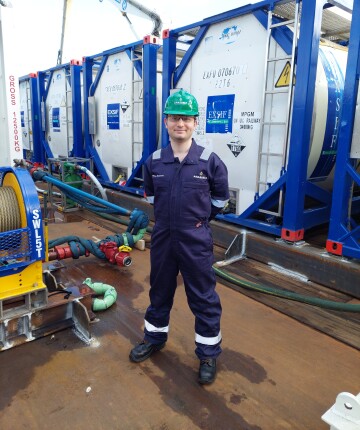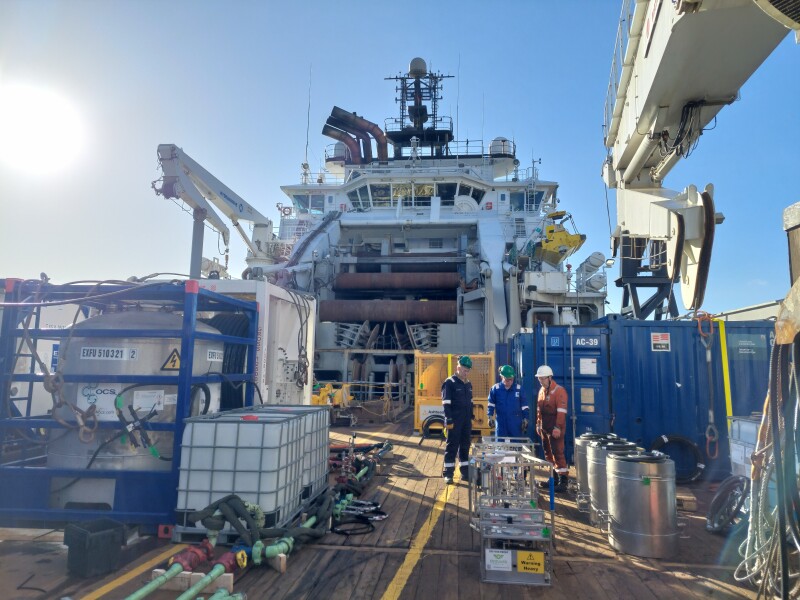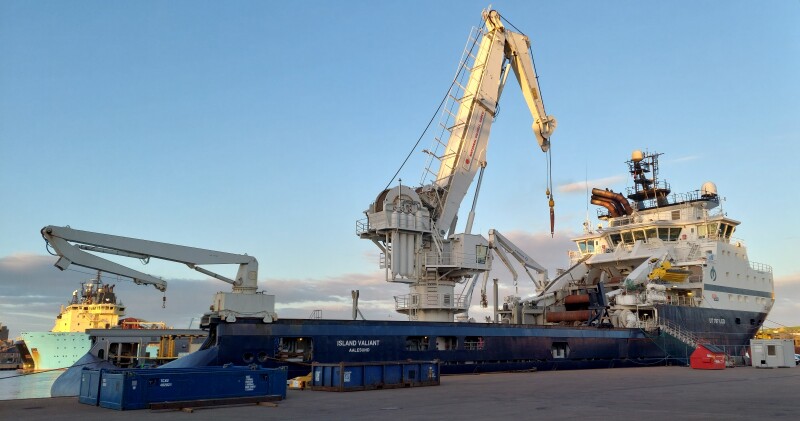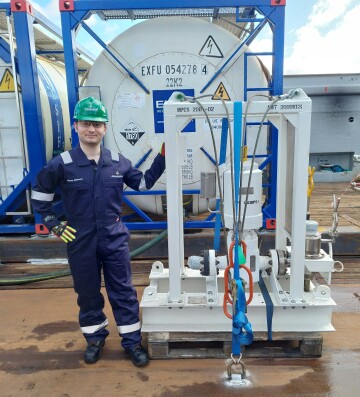In May, I had the opportunity to go offshore for a scale squeeze campaign on one of Anasuria Operating Co.'s (AOC's) subsea wells in the Teal field in the North Sea. The objective of this operation was to perform a scale treatment on a subsea well, located at a water depth of about 90 m (approximately 295 ft), via the annulus of the well, which is also designed for chemical injection.

I joined the trip with a colleague in the role of client representatives to observe the operation on behalf of AOC. At the same time, it was also a valuable chance for me to experience my first scale squeeze in person and deepen my own technical understanding of the process. The overall experience proved both technically interesting and personally rewarding, giving me a genuine insight into the day-to-day operations of a subsea well.
For those unfamiliar with the term, a scale squeeze is a preventative chemical treatment used to stop scale deposition inside oil and gas wells. Scale is a solid buildup of minerals, typically calcium carbonate or barium sulfate, which can clog the tubing string, pumps, and other flowing conduits. In mature fields like those in the North Sea, where water production is high and water contains significant minerals, scale can restrict flow, increase pressure on equipment, and even cause damage.

A scale squeeze involves pumping specific chemicals down the well to coat the tubing and equipment, preventing minerals from sticking. The chemicals are carefully chosen based on the produced-water composition, temperature, and production rate. The pumping sequences follow a structured schedule: a pre-flush to prepare the wellbore and displace unwanted fluids, the main treatment where the inhibitor is pumped into the formation, an overflush to push the inhibitor deeper and ensure good placement, and finally a tubing-volume displacement to clear the wellbore and return the well to normal operation. Done correctly, a scale squeeze helps keep the well flowing smoothly and avoids costly repairs or unplanned downtime.
From the moment we mobilized on the Island Valiant vessel, it was clear how much planning and coordination are required for such a campaign. Equipment was assembled and tested on deck, hoses connected, valves checked, and every step verified to prevent mistakes. Observing this highlighted how interconnected every part of the operation is and how even small oversights can create issues. Watching the teamwork gave me a stronger appreciation of the precision and attention to detail required in offshore operations.

Witnessing the sequences of the pumping program provided a clear insight into the process. Pressures, flow rates, and chemical volumes were closely monitored to ensure the treatment reached the correct sections of the well without causing problems. It is not just a matter of pumping chemicals in; it is a highly controlled process relying on both engineering expertise and operational skill. Seeing this firsthand helped me understand how theoretical knowledge translates into a practical subsea operation.
Additionally, one afternoon, the remotely operated vehicle (ROV) team generously gave us a tour of the vehicle, explaining its key components, how it is maintained, and the systems that enable it to perform such precise tasks at depth. This behind-the-scenes insight highlighted the complexity of the equipment and the level of preparation required before it is ever deployed. Learning in detail about the cameras, manipulators, and control systems gave me a deeper appreciation of what I was about to witness when the ROV was put to work subsea. It was therefore no surprise that one of the most memorable aspects of the trip was observing the ROV in action.
From the control room, I watched as the pilot guided it with remarkable precision to interact with the subsea equipment. Hoses were connected, valves operated, and tools positioned on the seabed in a carefully controlled manner. It felt like a perfectly choreographed sequence taking place underwater. The pilot’s composure and skill under pressure were striking, and seeing this firsthand made the operation far more vivid and informative than any manual or video ever could.
Teamwork stood out throughout the campaign. Engineers, technicians, marine crew, ROV operators, and chemical specialists worked seamlessly, often around the clock. Safety was central, with toolbox talks, risk assessments, and clear communication keeping everyone focused. Despite long shifts and minor challenges, the team remained coordinated and committed to completing the work efficiently and safely. It was a clear demonstration of how effective collaboration can make a complex operation run smoothly.
The campaign also emphasized the importance of scale squeezes for subsea wells in the North Sea. These wells are mature, with high mineral content in the produced water, and maintaining production efficiency is critical. Without regular scale treatments, wells can lose performance and operators may face costly interventions or unplanned shutdowns. A scale squeeze may seem straightforward, but it is essential for keeping production stable and avoiding bigger problems.
In the end, once the treatment was complete and the subsea well was brought back into production, it was clear the scale squeeze had been successful. The well flowed as expected, and analysis of the scale inhibitor residuals showed the chemicals were performing as intended. In simple terms, inhibitor residuals measure how much of the scale-preventing chemical remains in the produced fluids over time. If the residuals follow the expected pattern, or mirror results from previous scale squeezes on the same well, it shows the treatment is still protecting the well. In our case, the residuals closely matched those from the last scale squeeze, confirming the treatment would continue to safeguard the tubing and equipment over the next several years.
Going offshore for this campaign provided a much clearer picture of how subsea operations function in practice. Observing the planning, teamwork, and technical precision involved gave me a strong appreciation of the complexity of offshore work. It also reinforced why preparation, communication, and technical understanding are so important, even for procedures that may seem straightforward.
Looking back, this offshore trip gave me more than technical knowledge. It provided perspective on the scale of the work involved, the importance of teamwork, and why preventative treatments like scale squeeze are critical for well flow assurance. Attending in the role of a client witness gave me confidence in how the operation was executed, while the opportunity to observe everything firsthand added significantly to my own learning and development. It is an experience I will benefit from throughout my career, both as a reminder of what subsea operations really involve and as inspiration for how careful planning and teamwork can make complex operations succeed.

For anyone in the industry, the chance to go offshore is invaluable. Seeing operations in real time, understanding how teams coordinate, and witnessing the technology in action provides insights you cannot gain from a desk. Trips like this also remind me why working in the oil and gas industry is so interesting and rewarding. Being part of a sector that delivers energy to people, even in challenging times, is something I am genuinely proud of. Experiences like these show that there are opportunities for people at any stage of their career to learn, grow, and contribute meaningfully.






